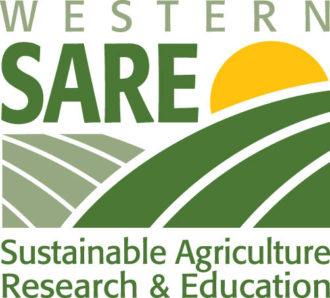Sustainable Agriculture Fact Sheet July 2020
State: Alaska
Commodity: Many
Need: Increased knowledge of agriculture professionals about the construction and production in high tunnels in Alaska, so they can better assist growers.
Background: High tunnels are regionally important in Alaska for season extension and provide a growing environment that allows for production of crops that would otherwise be unrealistic in the state. High tunnels are also increasingly popular – between 2010 and 2014, about $4 million was allocated through the Natural Resources Conservation Service Environmental Quality Incentives Program for the establishment of high tunnels, greenhouses or other growing equipment in Alaska.
The Need: To best serve the state’s farmers, Alaska Cooperative Service Agents and other agricultural professionals need be trained first. By learning, then teaching about, sustainable crop production in high tunnels, agriculture professionals can promote practices that help satisfy food needs in urban and rural Alaskan communities, enhance soil quality and productivity, and increase profitability for producers.
The Project: Led by Dr. Casey Matney of the University of Alaska, Fairbanks, the High Tunnels at High Latitudes project gathered 22 agriculture professionals from across Alaska received face-to-face classroom and field training on the applied use and construction of high tunnels for agriculture.
Instructional online videos have been gaining popular acceptance by farmers and the public. This is especially true, where many individuals rely on smartphones for access to media, even in more remote areas of Alaska. For the High Tunnels at High Latitudes Project, a series of 16 videos were scripted, recorded, and published for the University of Alaska Fairbanks Cooperative Extension Service YouTube Channel by trained Cooperative Extension Service Agents and select experienced farmers. These videos, with over 115 minutes of recorded footage, ranging in content from a simple overview of high tunnel structures to the applied strategies of growing crops.
The Impact: All 22 participants reported improved knowledge of high tunnels and their application for agriculture in Alaska. The videos produced through this project were viewed 4,320 times in their first year, providing a readily accessible and efficient form of information transfer to a growing group of farmers and producers that are eager for knowledge about high tunnels.
The Cooperative Extension Service Agents trained by the the High Tunnels and High Latitudes project provided a total of 19 face-to-face and distance delivered educational trainings on high tunnel use and construction from Fairbanks to Kodiak, reaching 184 participants. A majority of these participants were farmers, followed by Master Gardeners, the general public, and some additional agricultural professionals. Four new high tunnel farms on Kodiak attributed part of their success due to education received from extension agents.
CES agents from the University of Alaska Fairbanks (UAF) have spent the last three years engaged in instructing Alaskans about high tunnels. With recent statistics indicating that direct sales from farmers to local consumers are growing in Alaska at a rate 13 times the national average, these gains in knowledge put to practice could lead to improved production, cost reductions, and better management of our resources. In the end, such gains could greatly increase food security for Alaskans.
More information: camatney@alaska.edu (907) 907-262-5824
